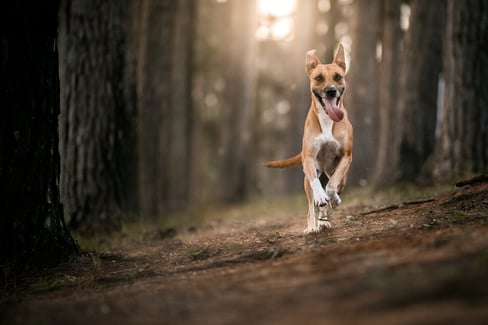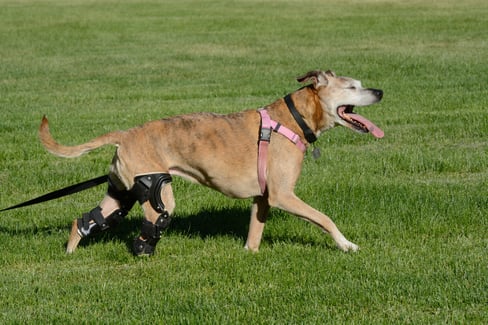Table of Contents
Think back to when you brought your dog home for the first time. Whether you got your dog when they were a rambunctious, happy little puppy or an adult that still showed that puppy side, the memories of them chewing on shoes or looking guilty with the contents of a pillow all over the floor usually cause a chuckle as you reach over to pat your best friend.
Nowadays, your senior pup may be more concerned about finding a sunny corner to nap or look at you quizzically when you suddenly start giving them their favorite treat more often than usual, which is most definitely not hiding pills.
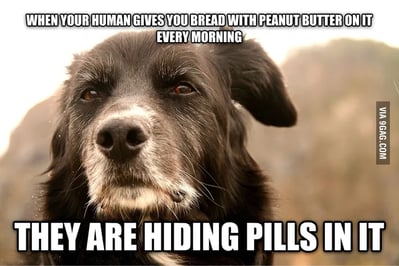
Your old dog may have some quips they didn’t have in their younger days that you might have to watch out for to ensure your aging dog remains healthy and happy. This article goes through some of the most important signs of aging dog, and what you can do to support your pup throughout their senior years.
Why Is My Dog Aging So Fast?
Did you know that science does not support the common belief that one dog year = seven human years?
Most people know that dogs don’t live as long as humans, but the lifespan of a dog can vary based on breed, health issues, genetics, and more. The science behind why your dog may seem to be aging quicker could be because they simply have a faster metabolism than humans. This means their hearts beat faster and work harder than ours. Another reason is that they grow up faster than us. While humans typically experience puberty between the ages of 10–16, dogs will experience it at 7–10 months.
The average lifespan of a dog is between 10–13 years, but typically smaller dogs live longer than larger breeds. This might help explain why they often think they are better than big dogs.
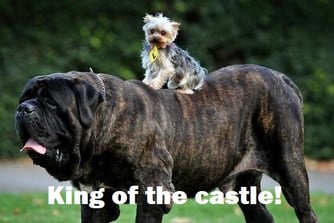
Small dog complex aside, the truth is that larger dogs do age faster than smaller dogs. You may have seen charts online that attempt to translate dog years into human years, so you can better understand how old your pup is, but the truth is that dogs don’t have a universal age of seniority because their life spans differ so much depending on their size.
The American Animal Hospital Association (AAHA) suggests that a dog becomes a senior when they reach 25% of the estimated lifespan for their breed.
The following chart can help you determine if your dog has reached their senior years or not:
|
Dog Breed |
Weight |
When Are They Seniors? |
|
Small or toy breeds (e.g., Chihuahua, Yorkshire Terrier, Shih Tzu) |
Less than 20 pounds |
6–9 years old |
|
Medium-sized breeds (e.g., Bulldog, Basset Hound, Border Collie) |
Between 20 to 50 pounds |
6–8 years old |
|
Large breeds (e.g., Alaskan Malamute, Borzoi, Boxer) |
Between 50 to 90 pounds |
6–7 years old |
|
Giant breeds (e.g., Bullmastiff, Great Dane, Irish Wolfhound) |
More than 90 pounds |
5–7 years old |
For people that don’t have purebred dogs and/or have adopted a dog that is clearly a bunch of different breeds mixed (or a mutt, as we lovingly call them), their weight and size should tell you which general category they fit in. A vet can also look at other physical characteristics, like teeth and body posture, to help determine age and classify them as senior or not.
Dog Aging Signs to Watch For
When your pup ages, their bodies and minds will experience changes, just like humans. While most changes are normal, it’s important to keep a close eye on anything physical or behavioural that could indicate a more serious dog health condition.
Common Dog Aging Signs
|
Physical |
Mental |
|
Changes in body shape
|
Frequent barking
|
|
Eye changes
|
Less temperature tolerance
|
|
Coat colour
|
Decreased energy
|
|
Teeth
|
|
|
Weight changes
|
|
|
Joint conditions
|
Physical Signs of Aging Dog
Keeping in mind that a dog’s aging process differs depending on their size, vets can use a few physical signs to help them get clues as to how old your pup may be.
1. Body Shape
It’s not just about whether your pup is naturally a chonky boi or not. As your pup ages, the way they distribute their fat changes. It’s like when you were 16 and had a flat stomach, and now you’re looking down and wondering where this big ol’ belly came from—it’s because of aging.
With dogs, fat pads typically start developing over your dog’s lower back or lumbar area (the top of their back legs). Sometimes, dog muscle wasting will show a more prominent spine, and the dog may develop a swayback (when they seem to sway back and forth more than usual while walking). This could mean nothing and simply indicate that your pup is just old, but it could also be a condition like spondylosis.
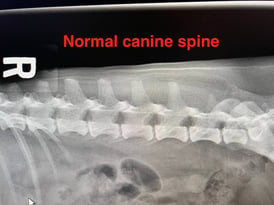
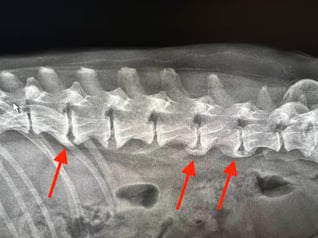
Normal dog spine versus one with spondylosis. Source
To know for sure, your vet will do a physical examination and perhaps take x-rays to determine whether your dog has the condition or not.
2. Eye Changes
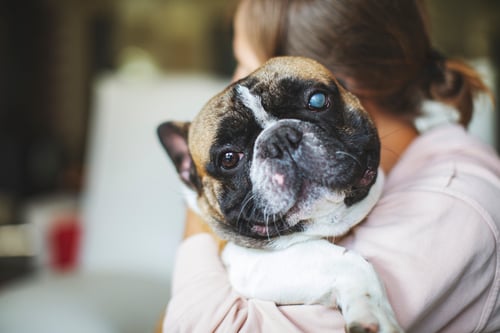
If your pup’s eyes are looking a little cloudy or bluish, it might be a sign that they have lenticular sclerosis, which is a common condition that happens with aging. While it can impair a dog’s vision to a degree, it’s a harmless condition that doesn't cause pain or discomfort; it also doesn’t lead to blindness (phew!).
3. Coat Colour
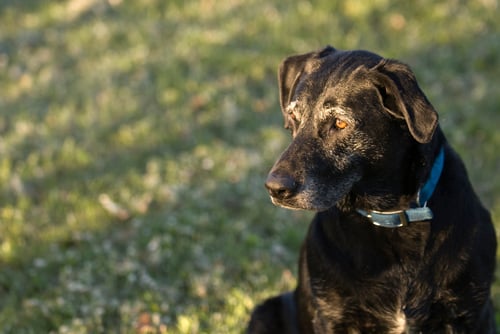
Like humans, signs of aging in dogs include changes in hair (fur) colour. It’s easier to tell on darker-coloured dogs, but you’ll likely notice some grey fur around their muzzle. This is a clear physical sign that your pup is getting on in their years. Enjoy your pup’s super cute new aesthetic, as a bit of grey fur is nothing to worry about.
4. Teeth
Vets can get a lot of valuable information from looking at your dog’s teeth. It’s easier for vets to tell age via teeth in young puppies, but it’s a less reliable method once all your dog’s adult teeth have grown in (typically by six months). Dental disease can affect a dog at any age, but generally, signs of tooth wear and loss and periodontal disease increase with age. If your dog has terrible breath that makes you want to gag, chances are there’s something worth exploring with their dental hygiene. A vet can examine your pup’s teeth, clean them, and treat any infection that may be present.
5. Weight Changes
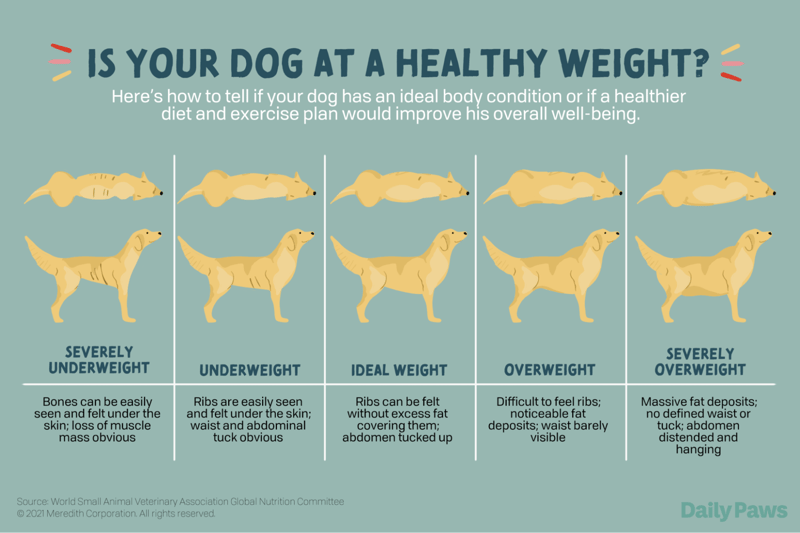
While the chart above shows general, helpful physical signs that you can look for to see if your dog is at a healthy weight, there is often more than goes into it for a senior pup. A number on a scale isn’t beneficial when there is so much variation in what a healthy dog can look like depending on breed and size. As your dog ages, you’ll also need to consider any other physical health issues that they may have that could affect what an ideal weight should look like. For example, because fat distribution in dogs can change as they age, a more exposed spine may not be a cause for concern in a senior pup, whereas it could be a sign of an underweight younger dog.
On the other hand, extra weight on a senior dog can also exaggerate mobility issues caused by conditions such as dog arthritis, so striving to keep your pup’s weight under control to not contribute to a mobility condition is even more important. Your vet can recommend a senior-friendly or diet dog food for your pup if need be.
6. Joint Conditions
One of the telltale signs of aging dog is stiff, uncomfortable joints. Your pup may:
- Experience stiffness
- Gain weight (as a result of restricted movement)
- Lick sore joints (to try and soothe them)
The truth is, the essential fluids that your pup’s body produces to keep their joints moving freely typically start to slow down as they age. Glucosamine for dogs usually slows production when they reach four to five years of age. Glucosamine is an essential amino sugar that your dog’s body produces, and when they have less of it, it can adversely affect their joints.
Thankfully, joint supplements are available for dogs that assist with replacing glucosamine alongside other important natural components like chondroitin. However, most pet joint supplements have fillers and other additives that can exasperate allergies, cause stomach upset, and otherwise adversely affect your senior dog, especially if they are sensitive.
That’s where TRI-ACTA for Pets comes in. It’s a joint supplement with no fillers or additives, just the good stuff like glucosamine and chondroitin (they work together to repair joints by generating new cartilage, muscle, and ligaments) and methylsulfonylmethane (abbreviated to MSM, a naturally-occurring anti-inflammatory). These components allow joints to remain stable, heal more effectively when they receive trauma, and help prevent age-related soreness as your dog grows.
If you’ve already got a senior dog and need a bit more “oomph”, TRI-ACTA H.A. contains the same formulation of ingredients as TRI-ACTA but adds hyaluronic acid, which improves the viscosity of synovial fluid in the joints. This helps provide maximum relief for conditions like arthritis, age-related soreness, hip dysplasia in dogs, and general joint-related pain and discomfort.
TRI-ACTA H.A. for Pets
Our maximum strength formula is optimally designed to accelerate the formation of cartilage, minimize inflammation, expedite the healing process, and improve joint conditions.
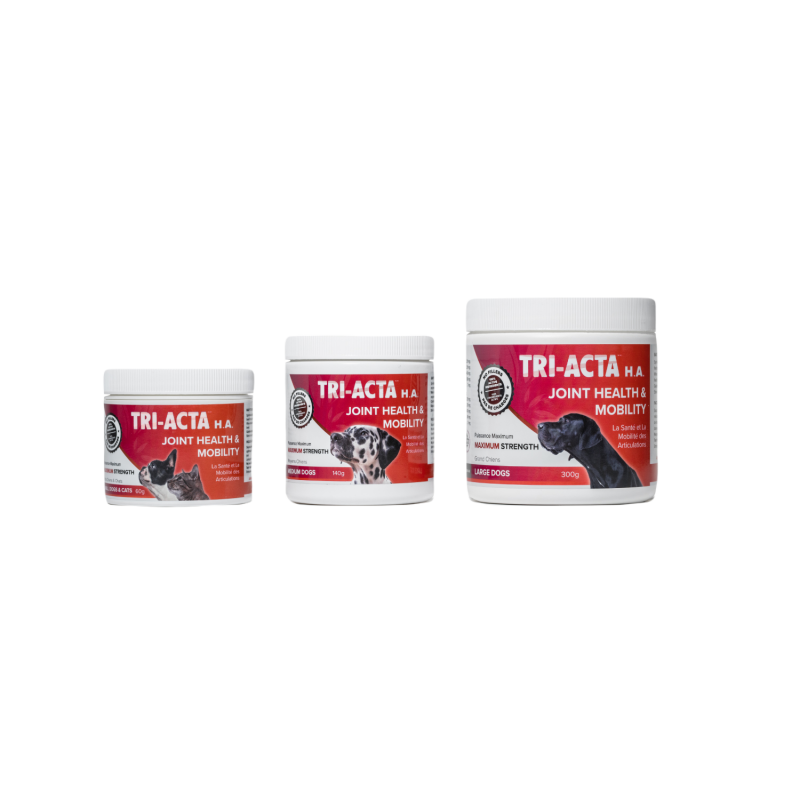
Mental Signs of Aging Dog
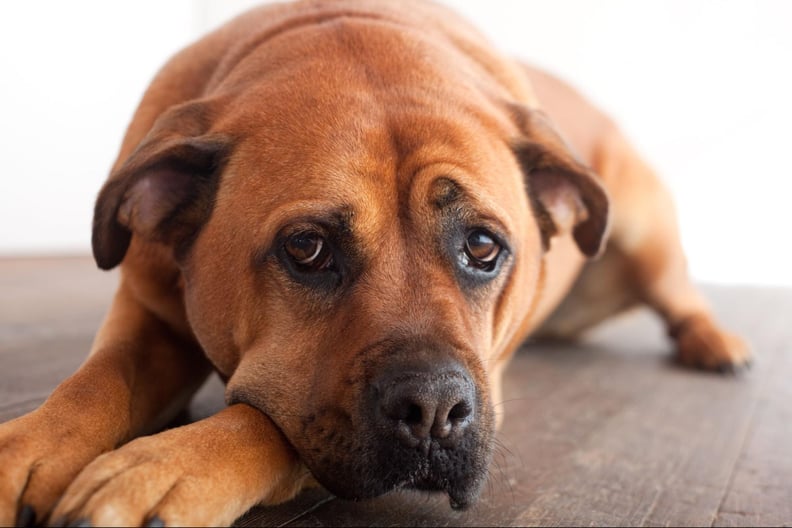
Sometimes, dog aging signs will be more mental than physical, so it’s important to be aware of any changes in how your dog is acting.
1. Behavioural Changes
If your dog usually reacts a certain way in a certain situation but starts to respond differently or over time seems to be losing interest in an activity that they once loved, this could be an indication of aging dog behaviour changes. When dogs age, their perception of the world around them may change. This could just be part of the normal aging process or an indication that something more serious is going on.
In general, here are some aging dog behaviour changes to watch out for:
- Frequent barking or whimpering could be your dog letting you know that they are in pain, confused, or anxious.
- If your dog is losing their hearing, they could stop responding to your voice, show confusion at your request, or be unbothered by loud noises that once caused them to respond. They may also bark or make more noise to get your attention. Since they can’t hear themselves, your dog may assume you can’t hear them, either.
- Senior dogs often experience anxiety in general or as a secondary aspect of other symptoms. Anxiety can cause your pup to bark or whimper, but thankfully there are a variety of helpful solutions: calming collars, treats, sprays, and even medication (prescribed by your vet).
2. Less Tolerance with Temperature
When humans get up in their years, they often pack on the layers for temperatures that, when they were young, would have been fine with just one sweater. Dogs are similar. When they age, dogs can develop issues with regulating their body temperature as efficiently as they used to, so they need a bit of extra support when it’s hot or cold outside.
- In the summer, ensure your senior dog has access to fresh, cool water. If you’re going out walking, bringing an extra water bottle with a collapsible pet dish is a great idea. Seek out shady spots during your walk to give your pup (and yourself) a chance to relax and regain energy.
- If you feel a bit too warm in your home, chances are your dog is feeling it too. Setting up a fan for them near their bed or favorite napping spot can help them cool down. Adding water to their wet food or kibble is another great way to ensure that they stay hydrated during those hot summer months.
- In the winter, outfitting your pup in a dog jacket and booties can help them stay warm in the frigid weather. Booties also help protect your dog’s feet from irritants like road salt, and for senior dogs that have mobility issues, give them a bit more grip on icy sidewalks.
3. Decreased Energy
Ever try to keep up with a five-year-old? Children and puppies have tons of energy, which diminishes as they age. The reality is that your senior dog is likely to sleep more, not be as enthusiastic about playtime or walks, and probably prefer to sit comfortably on your lap rather than explore.
While decreased energy is normal for senior pups, extreme lethargy is not. If your pup is so tired that they can’t reach the door to ask you to be let out to go to the bathroom, or they struggle to get up when you break out their favourite treat, it’s time for a trip to the vet.
What to Expect With an Aging Dog
Aside from the physical signs that your dog is aging, there are other things that you’re likely to notice—and should expect—as signs of aging dog.
In general, caring for senior dogs has differences from caring for a puppy or even a younger adult dog. They’re going to need more patience, adjustments to their diet (including treats), lighter exercise and play (e.g., short walks over running alongside a bike, and chill games like tug-o-war instead of having to run and catch a frisbee or ball) and more frequent trips to the vet.
In other words, senior dogs just need a little more TLC than younger dogs, but they’ll still have just as much (if not more) love to give you.
Treatments for Symptoms that Aging Dogs Experience
While sometimes our pups can age gracefully and with little to no issues, oftentimes senior dogs develop symptoms that need treatment so they can feel more comfortable in their old age. This section outlines some of the most common treatments you can implement immediately (with the advice of a vet).
The Importance of Proactive Care
You know what they say; hindsight is 20/20.
If you’re lucky enough to be reading this and you still have a puppy or an adult dog, you can start with proactive care right away. One of the best supplements you can give your dog as early as possible is TRI-ACTA. By giving your dog this joint supplement, their joints will be better supported through increased production of glucosamine, chondroitin, and MSM as they age, reducing soreness and joint conditions from developing.
TRI-ACTA for Pets
A proactive approach for developing and younger adult pets to maintain optimal joint health mobility, minimize inflammation and fend off age-related ailments.
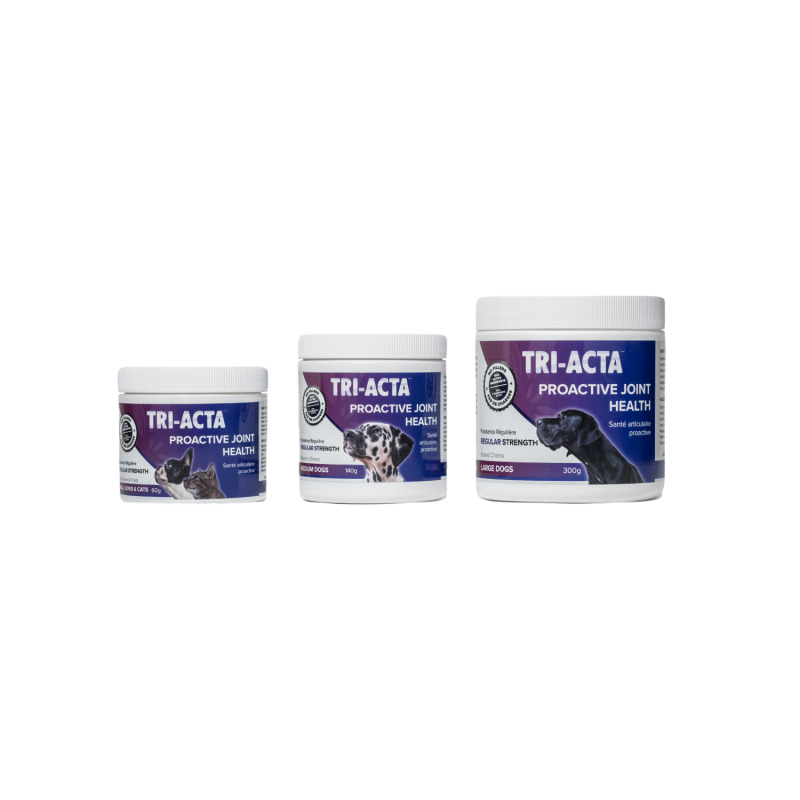
If your dog is already a senior, that doesn’t mean it’s too late to start giving them joint supplements. TRI-ACTA H.A. is developed specifically for seniors or pets with a heavier daily workload (e.g., sled dogs, herding dogs, etc.).
Other preventative measures that you can take to ensure that you give your dog the best chance of aging without developing serious issues include:
- Ensuring that they remain a healthy weight throughout their life
- Providing a good balance of exercise and rest
- Feeding them good food, such as a Canadian natural dog food diet or raw food diet for dogs
Diet and Exercise Changes
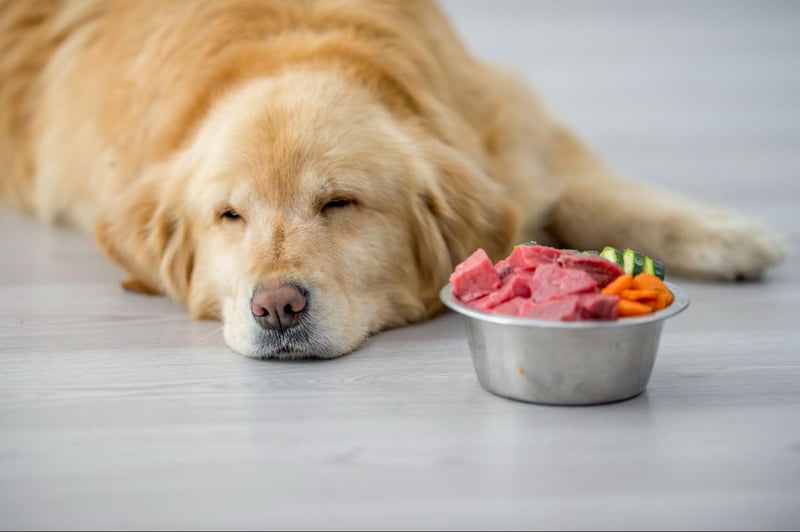
Even though senior dogs often don’t want to move around as much as they used to, they still need exercise. A slowing metabolism and changes in fat distribution can mean that it’s easier for your pup to put on weight, or but some dogs also become very picky in their golden years and therefore eat less.
Changing your senior dog's diet and exercise regimen might seem overwhelming, but the key is patience. Your pup may prefer shorter walks one day but be able to run around more the next. Similarly, your dog may prefer a certain type of food one day and the next day not care for it at all.
- Sometimes, senior dogs prefer wet food because it’s softer and easier to eat compared to kibble
- Feeding a dog bland diet can be helpful when your senior pup is experiencing tummy troubles to help them recover
- Being encouraging but not forcing your dog to exercise when they don’t want to, and only engaging in a low-key exercise like walks or swimming
Vet-Prescribed Medications
It’s not uncommon for aging dogs to need daily medication to stay healthy. Older dogs can develop conditions like diabetes, kidney disease, hyper or hypothyroidism, and other conditions that require you to administer medication to them regularly to keep the condition under control.
A vet may prescribe pills, liquid medication, or special food to treat the condition that your dog has been diagnosed with. Just like humans, it’s important that:
- Your pup actually takes the medication that your vet prescribes. Pill pocket treats, hiding pills in irresistible foods like peanut butter, a piece of hot dog, or cheese, are often effective for getting your dog to take their medication. Liquid meds may have to be squirted directly into your dog’s mouth. If you have trouble getting your dog to accept medication, it’s worth speaking with your vet about alternative options. Sometimes pills can be compounded into liquid, and some medications, like thyroid meds, can even be given as a cream that you rub on the inside of your dog’s ears.
- Medications are given at the same time every day so the buildup of the medication in your dog’s body remains consistent.
- Special food is fed exclusively unless your vet indicates that the odd treat or snack is ok.
Summary
It can sometimes be a bit scary to watch your beloved dog age, especially as they start slowing down and showing other signs that they are getting older. In many cases, signs of an aging dog are nothing to worry about, but it is still important to keep a close eye on your pup to ensure they remain happy and healthy as they experience their golden years.
Integricare provides effective therapeutic pet joint health solutions. Discover more about our pet supplements.
TRI-ACTA H.A. for Pets
Our maximum strength formula is optimally designed to accelerate the formation of cartilage, minimize inflammation, expedite the healing process, and improve joint conditions.

Newsletter Signup
Subscribe to our newsletter to receive the latest news and exclusive offers.
.jpg?height=2000&name=Cliick_Integricare-DISPLAY-REVISEDV2%20(1).jpg)
Proactive & Therapeutic Joint Supplements
When given daily, Integricare joint supplements recover bone and joint injuries faster and help prevent mobility injuries from happening in the first place.








